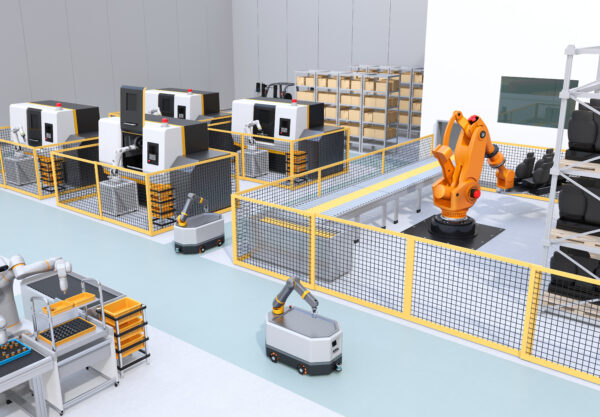How do you choose between cobots and industrial robots? Today’s automation integrators know there is no one size fits all solution, but there are a variety of robotic solutions depending on your needs, your budget, and your end goals. We would like to highlight the simple differences between these two main categories of robotic machines.
Why You Should Choose a Cobot
Safe to Work Closely Alongside Humans
Collaborative robots, AKA cobots, are designed to work on simple, repetitive tasks alongside humans with safety systems. Force and power limitations are designed in every joint of a cobot so any possible collision can be detected and prevented. The combination of lower payloads and speeds minimize the chance for injury when coupled with traditional safety training. Industrial robots require separate safety systems, safeguards, and protective cages.
Perfect for simple programming for low volume tasks
Whether you are using simple icon-based programming, pendent programming software, or intuitive hand guiding techniques where you manually map points to perform a task, your machine tender can offload high mix, low volume applications without loss of quality or consistency. They can match the speed of your operator to work at their pace.
Lighter production floor footprint
While each cobot does require securing for safety, their smaller size, lower payloads, and lower speeds means you can have multiple small machines on your floor. They can be moved, resecured, and programmed with different tasks. Ask us about our Automation Fixture System kits and carts, perfect for quick prep and cell reassignment.
Swifter ‘out of the box experience’
Because of their simpler tasks, smaller size, and lighter safety requirements, the integrator takes on all of the complex programming, communication protocols, and custom grippers that the cobot depends on for swift install and reassignment. Months of diligent integration planning allows for cobot setup in a matter of hours. An integrator can even facilitate easier in house mechanical engineering. Keep in mind though that if you are considering having a cobot move toxic chemicals, wield a torch, or use a knife, those applications may be better suited for an industrial robot.
Why You Should Choose an Industrial Robot
Higher complexity of tasks
Especially when it comes to custom automations, an industrial robot’s programmed tasks are broader, more complex, and often come with intuitive machine learning programming. For larger, complex manufacturing setups, full size industrial robots offer better economies of scale.
Higher production speed and volume
Industrial robots vastly outpace the speed and volume human labor and cobots. Industrial robots are essential for mass production.
Uptime
Industrial robots are traditionally more robust than cobots, if you have tasks that emphasize higher uptime percentages, an industrial robot might be a better fit.
Harsh Environment
Industrial robots tend to have higher Ingress Protection (IP) ratings. Integrating a project that can work in areas with dusty environments, food or wash down environments, harsh chemical environments, or other severe situations is easier with an industrial robot.
Higher load capacity
While a cobot might manage 1200 mm (about 3.94 ft) reach or payloads around 20 kg, industrial robots capable of lifting over 1000 kg (about 2204.62 lb.) can have reach over 4500 mm (about 14.76 ft). If you have a payload larger than 35 lbs, it makes much more sense to use an industrial robot.
Less hands-on operation
By definition, an industrial robot runs with few human operators. Programmers do not need advanced programming skills to use them, and machine learning AI software can pick processes and improve on them.
Questions to ask yourself before you contact your automation integrator
- Cycle times- What are your expectations for throughput and performance? If you want to go faster than a human worker or at speeds that might endanger workers in close proximity, a robot might be the best solution. If you’re looking to mimic the speeds of a worker, a cobot might be the better choice.
- Volume- Are you seeking high mix, low volume manufacturing? Are you chasing every task you want? The flexibility and adjustability of a cobot might compliment those variable tasks better than a fixed robot. Do your goals involve high volume manufacturing with low variation? Are you aiming for the 80/20 targets that will grow your business the fastest? An industrial robot can typically meet those higher volume low variable products that you seek your mass production profits from.
- Size and weight- How large and heavy are the parts your robot will need to manufacture? Will you need a longer reach? A cobot is usually limited on strength roughly 35 lbs. If you need a greater payload than 35 lbs, a robot make more sense.
- Application- Are your ideal automations performing tasks involving material removal, assembly, finishing, machine tending, pick and place, or quality control? Any task that poses a human risk, requires high uptime, volume, or speed is best performed by a robot. When you need flexibility and speed is not a concern, a cobot is your friend.
- Setting- What is the size of your manufacturing floor? Do you have room for a large caged robot and the corresponding safety zones? Or do you need a more compact cobot envelope?
- Automation goals- Are you seeking improved throughput, turnaround times, freeing up skilled workers, improving safety, maximizing quality, minimizing waste, etc.? Share these with DEVELOP LLC! We’re experts at translating your specific needs into a custom robotic, cobotic, or machine integration.
Let your automation integrator answer these questions
DEVELOP LLC has dedicated itself to educating our customers beyond what our competitors are willing to do with in depth Automation Assessments. We establish a partnership with end goals of self-reliability. Tell us more about your project, schedule a virtual meeting, or call (262)-622-6104 to learn more about how we can help you with your succession plan.
Authors:
Sean McKittrick and Matt Moseman

